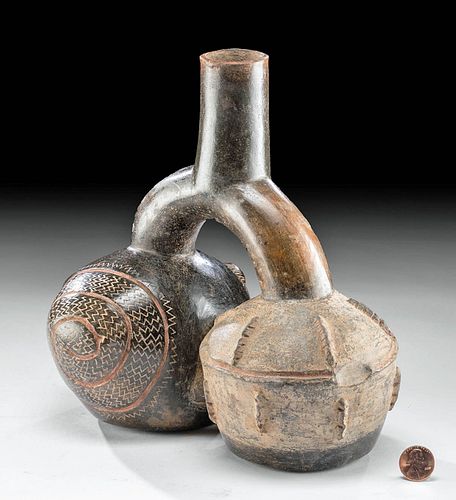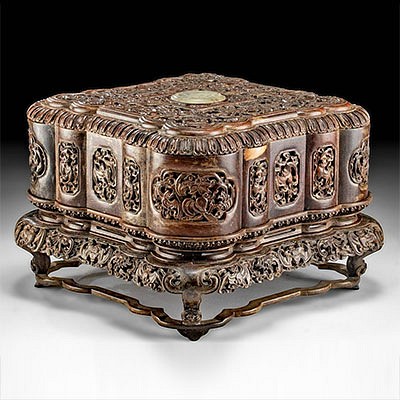Chavin Tembladera Pottery Vessel with Two Shells
Lot 75
About Seller
Artemis Gallery
686 S Taylor Ave, Ste 106
Louisville, CO 80027
United States
Selling antiquities, ancient and ethnographic art online since 1993, Artemis Gallery specializes in Classical Antiquities (Egyptian, Greek, Roman, Near Eastern), Asian, Pre-Columbian, African / Tribal / Oceanographic art. Our extensive inventory includes pottery, stone, metal, wood, glass and textil...Read more
Categories
Estimate:
$3,000 - $4,500
Absentee vs Live bid
Two ways to bid:
- Leave a max absentee bid and the platform will bid on your behalf up to your maximum bid during the live auction.
- Bid live during the auction and your bids will be submitted real-time to the auctioneer.
Bid Increments
| Price | Bid Increment |
|---|---|
| $0 | $25 |
| $300 | $50 |
| $1,000 | $100 |
| $2,000 | $250 |
| $5,000 | $500 |
| $10,000 | $1,000 |
| $20,000 | $2,500 |
| $50,000 | $5,000 |
| $100,000 | $10,000 |
| $200,000 | $20,000 |
About Auction
By Artemis Gallery
Apr 8, 2021
Set Reminder
2021-04-08 10:00:00
2021-04-08 10:00:00
America/New_York
Bidsquare
Bidsquare : Fine Antiquities | Asian | Ethnographic Art
https://www.bidsquare.com/auctions/artemis-gallery/fine-antiquities-asian-ethnographic-art-6770
Features classical antiquities, ancient and ethnographic art from cultures encompassing the globe. Egyptian, Greek, Roman, Etruscan, Near Eastern, Asian, Pre-Columbian, Native American, African / Tribal, Oceanic, Spanish Colonial, Russian, Fine Art, so much more! All legally acquired, legal to sell. Artemis Gallery info@artemisgallery.com
Features classical antiquities, ancient and ethnographic art from cultures encompassing the globe. Egyptian, Greek, Roman, Etruscan, Near Eastern, Asian, Pre-Columbian, Native American, African / Tribal, Oceanic, Spanish Colonial, Russian, Fine Art, so much more! All legally acquired, legal to sell. Artemis Gallery info@artemisgallery.com
- Lot Description
Pre-Columbian, North Coast Peru, Chavin culture, Tembladera phase, ca. 800 to 500 BCE. A remarkable mold-made pottery stirrup vessel presenting a double-chamber body in the form of a conch shell and a spondylus shell. Skillfully formed, one face of the conch shell is rounded and incised with a spiral to represent the apex of the shell, while the opposite face is pointed to create the siphonal canal and the partially risen side indicates the shell's outer lip. Alternatively, the spondylus shell features characteristic spiky ridges. Boasting a lustrous burnish over black and cream paints, the ancient vessel has been intricately detailed by hand, exhibiting decorative zigzag motifs on the conch shell and a horizontal band around the spondylus shell. Given its size and fine decoration, this vessel was likely created to hold fermented corn beer or chicha cherished by the ancients of the Chavin culture - "the mother civilization of the Andes" that is oftentimes compared to the Olmec in Mexico in terms of artistic inspiration for later periods. Size: 8.5" L x 5.75" W x 8.25" H (21.6 cm x 14.6 cm x 21 cm)
Shells were associated with the primordial sea and the Pre-Columbian world's mythical beginnings. In addition, shells were linked to breath, wind, and moisture. Just as beach lovers today often claim to hear the sounds of the ocean when they press a shell to their ears, the ancients of the Americas considered shells to deliver the sounds, moisture, and aromas of the ocean. This is why shells were associated with music and sound; used as trumpets or to create rattles on dance costumes, their spiraled forms were also used as the models for popular wave motifs.
Spondylus shells, also known as spiny or thorny oysters for obvious reasons, have been revered by Andean peoples since the Pre-Columbian era. In addition to being featured in their artwork and used as currency, Spondylus pieces served as sacred offerings to Pachamama, the earth/time mother, a version of Mother Nature. The Spondylus shell carries numerous symbolic meanings. A symbol of fertility and elite social status, it was also believed to be an omen of rain, warning the indigenous of El Nino. In fact, the Spondylus shell only appears when the water becomes warmer during December - the time of the El Nino current - immediately before the rainy season.
This pottery vessel is an example of a skeuomorph, the representation of one material, in this case shells, made with another, in this case pottery. The ancients frequently played with this idea, modeling clay vessels or stone works in the forms of gourds, plants, or shells like this example. The resulting form would then embody the symbolism of a more perishable medium, but translate it into a stronger medium.
Provenance: private Hawaii, USA collection; ex-private Hans Juergen Westermann collection, Germany, collected from 1950 to 1960s
All items legal to buy/sell under U.S. Statute covering cultural patrimony Code 2600, CHAPTER 14, and are guaranteed to be as described or your money back.
A Certificate of Authenticity will accompany all winning bids.
We ship worldwide and handle all shipping in-house for your convenience.
#162989Collection label on base. Repaired from several pieces with restoration over break lines and possible restoration to rim. Otherwise, excellent with impressive remaining pigment and detail.Condition
- Shipping Info
-
All shipping is handled in-house for your convenience. Your invoice from Artemis Gallery will include shipping calculation instructions. If in doubt, please inquire BEFORE bidding for estimated shipping costs for individual items.
-
- Buyer's Premium



 EUR
EUR CAD
CAD AUD
AUD GBP
GBP MXN
MXN HKD
HKD CNY
CNY MYR
MYR SEK
SEK SGD
SGD CHF
CHF THB
THB














